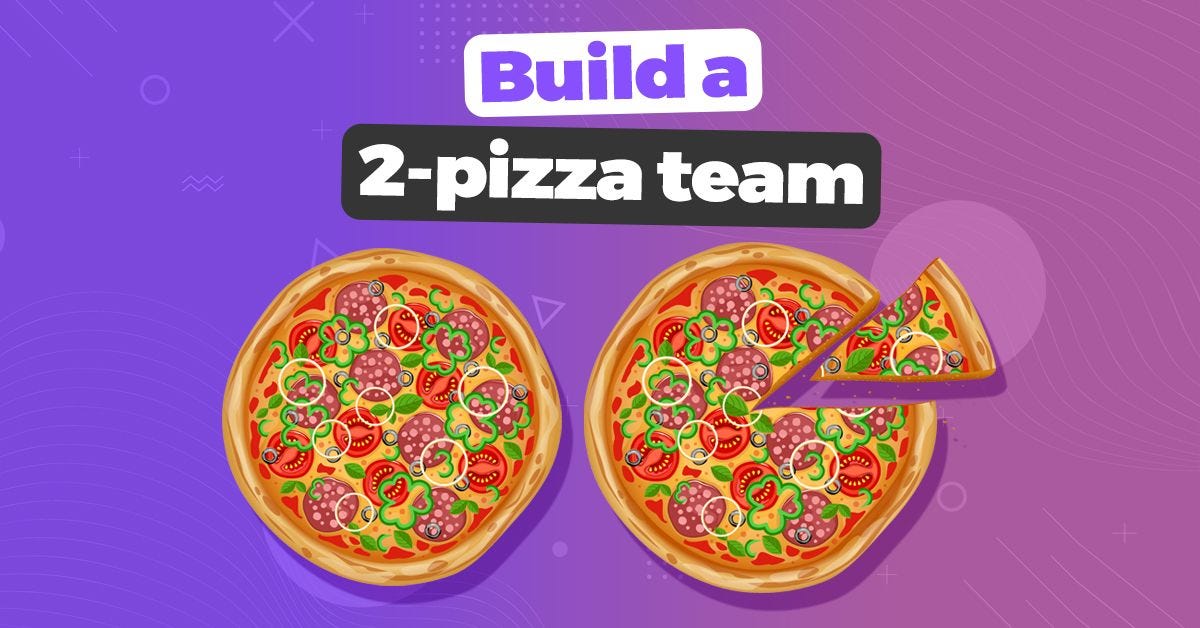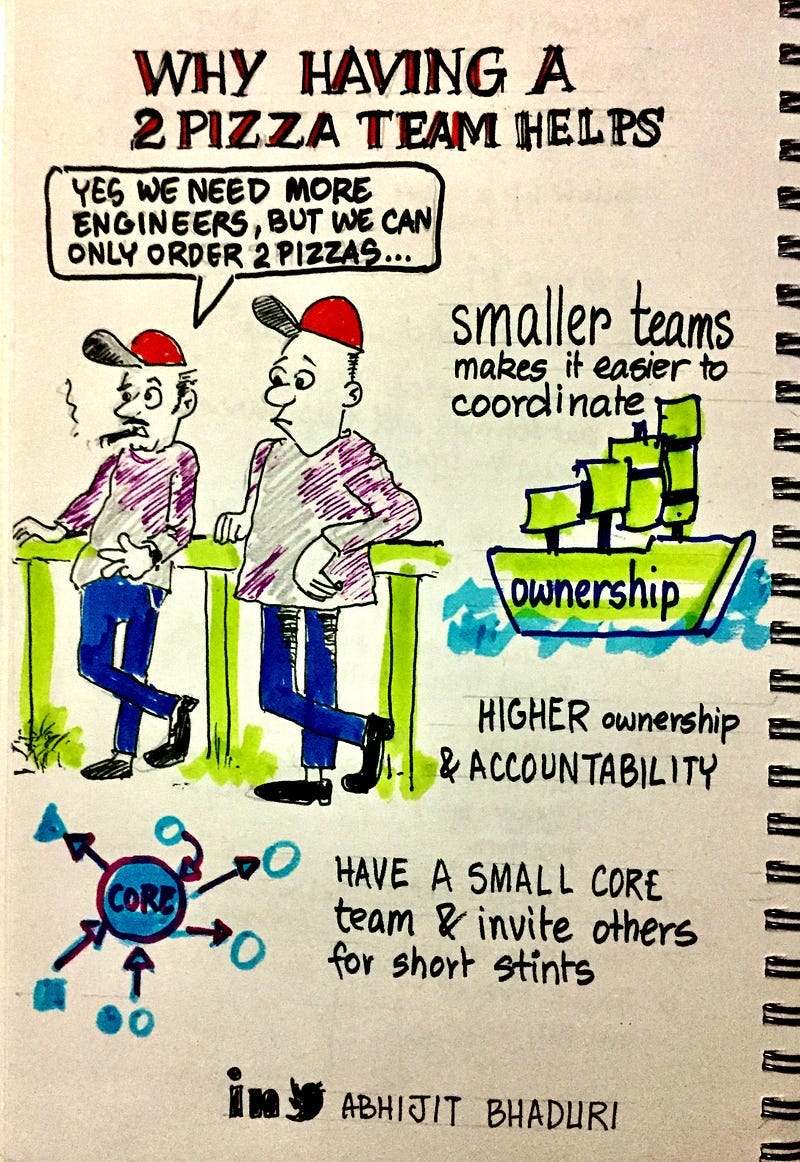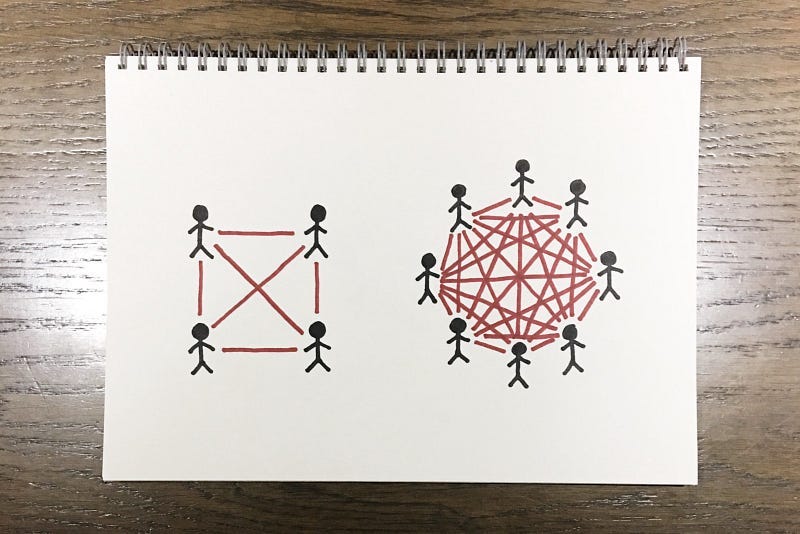If you can’t feed a team with two pizzas, it’s too large. — Jeff Bezos
Never have meetings where two pizzas would not be enough to feed the entire group. Large meetings are tremendous time wasters.
As group size rises, all sorts of issues spring up. Individual performance levels diminish and people start to grow less engaged. So while larger teams may be getting more done altogether, it’s happening at a rate lower than the sum of individual efforts.
Less can be more when it comes to optimum team size — particularly for startups. So, what is the right size of team? 8–10 members should be an ideal team size for startups, but with the growth, it is important to increase members to handle the increasing volume of work. In such cases, it is best to break the startup into different teams that can each be fed with 2 pizzas.
Why small teams are better
With small teams there are so many benefits. Not only things move very fast, there are also less miscommunication and conflict among team members. Let’s discuss details on why “small is better” -
1. Small Teams Work Faster
Smaller teams cost less (in the short term, at least). Of course a small team that needs to work longer, and overtime, may end up being more expensive than a larger team that might have been able to achieve its goal more quickly due to pure man-hours, but this is the case of a team being too small. A small team that is not over-taxed will provide greater efficiency and productivity. Ultimately, a small team works faster than a larger team, runs more efficiently, and has less overhead.
2. Group Vs. Individual Productivity
Research dating back a century has shown that as a team’s size increases, efforts from each person on the team correspondingly decrease. (This is known as the Ringelmann Effect.)
On the flip side, people increase their effort when they’re on smaller teams, as they feel more responsible for the output based on their efforts. Organizing a large group into several small teams allows people more autonomy to wear multiple hats and to be more entrepreneurial (this works well for us at Codegiant). Smaller teams also allow each person a chance to take greater ownership of the results, and to tap into their natural reserves of intrinsic motivation.
3. Keep it simple
There’s no doubt that the more people on a team, the larger the number of potential interactions, and the more unwieldy and frustrating projects can become. Smaller teams with the right combination of people can be more agile and flexible. They should consist of people who rely on each other to get things done. Doing so improves the “flow” of delivering value through experimentation and continual improvement. Focusing on the flow efficiency of a team is the key to getting the most out of lean, and ultimately improving productivity.
4. Better Communication
Communication within a small team is much simpler and more efficient than in a larger team, in part because there are fewer communication channels. Consider the number of combinations of three people meetings for a team of 5 people:
ABC, ABD, ABE, ACD, ACE, BCD, BCE, ADE, BDE, CDE = 10.
Now consider the possible combinations if there are twenty members on the team… 1,140.
It is this exponential growth in possible communication combinations that creates communication problems within a large group. While which modern technology, it is possible to communicate with everyone at once, it also means that everyone else is able to communicate with everyone else at once… being cc’ed in on every email, being alerted by every new chat message… It is simply impossible as a manager to maintain communication with a team of that size.
5. No fade into the background
With large teams, there is lower participation in group activities and discussions. Similarly, the disparity in the amount of participation among team members increases. The problems can prevent a group of individuals from jelling into a cohesive, high-performing team.
6. Small teams are more satisfying
With a small team, one person’s contributions are more visible and meaningful. This is perhaps one reason why research has shown that participation on a large team is less satisfying to team members. Motivation costs are lower in small teams.
7. Better engagement
In 2013 Gallup released a report called “The State of The American Workplace,” in it they found that smaller companies had more engaged employees. In fact, 42% of employees working at companies of 10 or fewer were engaged at work versus only 30% of employees at large companies. Now in this instance these 10 person companies can easily be equivalent to 10 person teams.
We could all learn a lesson from thinking smaller. Putting some thought and effort into how to communicate better, opening up channels for more conversations, and strengthening supportive and meaningful emotional connections make work about creating something great with your teammates instead of fading away on some stressful, lonely death march.
Final 2-cents
When you start a new team, make it a small team. You probably don’t need as many people as you think. Your ideal team size may well be four or five people — but make sure they have diverse enough skills to be able to deliver the work. At Codegiant, we have just 5 team members.
Only add additional members to the team if you must. Don’t just add members because you want to get things done quicker. The result might even end up being quite the opposite. Never go beyond 9 members in a team.
If your team is already so big that you aren’t getting the benefits of a small team described above, suggest an experiment to split into two teams for a couple of sprints and see whether it works better.






